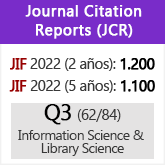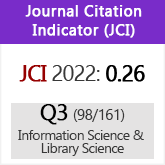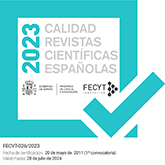Visualización mediática de la ciencia: tipología de la infografía científica de prensa
DOI:
https://doi.org/10.3989/redc.2020.2.1643Palabras clave:
Periodismo científico, infografía, alfabetización mediática, diseño de información, divulgación científica, visualización de datosResumen
Este artículo explora el tratamiento informativo de la infografía de la prensa internacional para emprender de manera eficaz procesos de comunicación y divulgación de los hechos relativos a la Ciencia y Tecnología (CyT). La integración de un método de análisis de contenido, aplicado a una muestra seleccionada de mejores prácticas en materia de infografía de periódicos y revistas que han recibido reconocimiento internacional a través de los premios Malofiej (N=149), fueron codificadas y analizadas para identificar características y patrones detallados con base a tres ejes de estudio: el planteamiento informativo (¿qué se dice?), los objetos gráficos y su correspondencia (¿cómo se dice?) y la función que desempeñan los infográficos (¿para qué se dice?). Los resultados indican que estas piezas informativas emplean distintos planteamientos informativos que reflejan en sus mensajes, los cuales conllevan al uso particular de determinados recursos de expresión (objetos gráficos), desempeñando de manera conjunta, diversas funciones comunicativas por parte del emisor con respecto al público al que se dirige; lo anterior, llevó a la conformación y descripción de tres modelos de infografía científica de prensa.
Descargas
Citas
Alcíbar, M. (2017). Information visualisation as a resource for popularising the technical-biomedical aspects of the last Ebola virus epidemic: The case of the Spanish reference press. Public Understanding of Science, 27(3), 365-381. https://doi.org/10.1177/0963662517702047 PMid:28393588
Ancker, J. S.; Senathirajah, Y.; Kukafka, R.; Starren, J. B. (2006). Design features of graphs in health risk communication: A systematic review. Journal of the American Medical Informatics Association, 13(6), 608- 618. https://doi.org/10.1197/jamia.M2115 PMid:16929039 PMCid:PMC1656964
Baglama, B.; Yucesoy, Y.; Uzunboylu, H.; Ozcan, D. (2017). Can Infographics Facilitate the Learning of Individuals with Mathematical Learning Difficulties?. International Journal of Cognitive Research in Science, Engineering and Education/IJCRSEE, 5(2), 119-127. https://doi.org/10.5937/ijcrsee1702119B
Berenguer, X. (1991). La imatge sintètica com llenguatge. Temes de disseny (5), 89-96. Recuperado de: https:// www.raco.cat/index.php/Temes/article/view/29196
Bucchi, M.; Saracino, B. (2016). Visual science literacy: Images and public understanding of science in the digital age. Science Communication 38(6): 812- 819. https://doi.org/10.1177/1075547016677833
Cairo, A. (2017). Nerd journalism: How Data and Digital Technology Transformed News Graphics. Tesis doctoral, Universitat Oberta de Catalunya.
Cairo, A. (2011). El arte funcional: infografía y visualización de información. Madrid: Alamut.
Cairo, A. (2008). Infografia 2.0: Visualización interactiva de información en prensa. Madrid: Alamut.
Clark, R.; Lyons, C. (2010). Graphics for learning: Proven guidelines for planning, designing, and evaluating visuals in training materials. San Francisco: John Wiley & Sons.
Cortiñas, S. (2010). La Contribució de la Infografía al Desenvolupament del Periodisme Científic. Periodística: revista acadèmica (12), 65-81.
Costa, J. (1999). Esquemática. Barcelona: Paidós.
Darian, S. (2001). More than meets the eye. The role of visuals in science textbooks. LSP and professional communication (2001-2008), 1(1).
Davidson, R. (2014). Using Infographics in the Science Classroom. The Science Teacher, 81(3): 34-39.
Dur, B. I. U. (2012). Analysis of data visualizations in daily newspapers in terms of graphic design. Procedia- Social and Behavioral Sciences, 51, 278-283. https://doi.org/10.1016/j.sbspro.2012.08.159
Elías, C. (2008). Fundamentos de periodismo científico y divulgación mediática. Madrid: Alianza Editorial.
Engelhardt, Y. (2002). The language of graphics: A framework for the analysis of syntax and meaning in maps, charts and diagrams. Unpublished Ph.D. thesis, Institute for Logic, Language and Computation, University of Amsterdam, The Netherlands.
Galesic, M., y Garcia-Retamero, R. (2011). Communicating consequences of risky behaviors: Life expectancy counseling, 82(1), 30-35. https://doi.org/10.1016/j.pec.2010.02.008 PMid:20219316
García-Retamero, R.; Cokely, E. (2013). Communicating health risks with visual aids. Current Directions in Psychological Science 22(5): 392-399. https://doi.org/10.1177/0963721413491570
Ghenghea, V. A. (1998). The Impact of Effective Diagram Design on LSP Text Understanding. In Proceedings of the 11th European Symposium on LSP Identity and Interface Research, Knowledge and Society, Copenhagen, Copenhagen Business School (pp. 783-793).
Hernando, M. C. (1997). Manual de periodismo científico. Bosch Casa Editorial.
Kibar, P. N., y Akkoyunlu, B. (2014). A new approach to equip students with visual literacy skills: Use of infographics in education. In European Conference on Information Literacy (pp. 456-465). Cham: Springer. https://doi.org/10.1007/978-3-319-14136-7_48
Lazard, A.; Atkinson, L. (2015). Putting environmental infographics center stage: The role of visuals at the elaboration likelihood model's critical point of persuasion. Science Communication 37(1): 6-33. https://doi.org/10.1177/1075547014555997
Lohse, G. L.; Biolsi, K.; Walker, N.; Rueter, H. H. (1994). A classification of visual representations. Communications of the ACM, 37(12), 36-50. https://doi.org/10.1145/198366.198376
Marsh, E.; Domas, M. (2003). A taxonomy of relationships between images and text. Journal of Documentation, 59 (6), 647-672. https://doi.org/10.1108/00220410310506303
Mc Sween-Cadieux, E.; Fillol, A.; Ridde, V.; Dagenais, C. (2018). Letter to the editor in response to "No difference in knowledge obtained from infographic or plain language summary of a Cochrane systematic review: three randomized controlled trials" by Buljan et al.(2017). Journal of Clinical Epidemiology. https://doi.org/10.1016/j.jclinepi.2018.02.020 PMid:29518476
Mitchell, D.; Morris, J.; Meredith, J.; Bishop, N. (2017). Chemistry Infographics: Experimenting with Creativity and Information Literacy. En Liberal Arts Strategies for the Chemistry Classroom (pp. 113-131). American Chemical Society. https://doi.org/10.1021/bk-2017-1266.ch007
Monterde, R. A. M. (2002). Relationship and dependency between linguistic and non-linguistic forms of concept representation: a study of texts and addressed to experts and students. LSP and Professional Communication, 2 (2), 31-48.
Montes, M. (2017). El Tratamiento informativo de la infografía científica de prensa. Tesis doctoral, Universitat Pompeu Fabra.
Occa, A.; Suggs, L. (2016). Communicating breast cancer screening with young women: An experimental test of didactic and narrative messages using video and infographics. Journal of Health Communication 21(1). https://doi.org/10.1080/10810730.2015.1018611 PMid:26147625
Ozdal, H.; Ozdamli, F. (2017). The Effect of Infographics in Mobile Learning: Case Study in Primary School. Journal of Universal Computer Science, 23(12), 1256-1275.
Prieto, J. A. (2009). Traducción e imagen: la información visual en textos especializados. Granada: Tragacanto.
Puebla, J. G.; Gould, M. (1994). SIG: sistemas de información geográfica. Síntesis.
Shafipoor, M.; Sarayloo, R.; Shafipoor, A. (2016). Infographic (information graphic): A tool for increasing the efficiency of teaching and learning processes. International Academic Journal of Innovative Research, 3(2), 1-7. https://iaiest.com/data-cms/articles/20191107034716pmIAJPL1510004.pdf
Shanks, J. D.; Izumi, B.; Sun, C.; Martin, A.; Byker Shanks, C. (2017). Teaching undergraduate students to Visualize and Communicate Public Health data with infographics. Frontiers in public health, 5, 315. https://doi.org/10.3389/fpubh.2017.00315 PMid:29226120 PMCid:PMC5705557
Stone, E. R., Bruine de Bruin, W., Wilkins, A. M., Boker, E. M., y MacDonald Gibson, J. (2017). Designing graphs to communicate risks: Understanding how the choice of graphical format influences decision making. Risk analysis, 37(4), 612-628. https://doi.org/10.1111/risa.12660 PMid:27862121
Ware, C. (2012). Information visualization: perception for design. Elsevier.
Yau, N. (2013). Data points: visualization that means something. John Wiley & Sons.
Publicado
Cómo citar
Número
Sección
Licencia
Derechos de autor 2020 Consejo Superior de Investigaciones Científicas (CSIC)

Esta obra está bajo una licencia internacional Creative Commons Atribución 4.0.
© CSIC. Los originales publicados en las ediciones impresa y electrónica de esta Revista son propiedad del Consejo Superior de Investigaciones Científicas, siendo necesario citar la procedencia en cualquier reproducción parcial o total.Salvo indicación contraria, todos los contenidos de la edición electrónica se distribuyen bajo una licencia de uso y distribución “Creative Commons Reconocimiento 4.0 Internacional ” (CC BY 4.0). Puede consultar desde aquí la versión informativa y el texto legal de la licencia. Esta circunstancia ha de hacerse constar expresamente de esta forma cuando sea necesario.
No se autoriza el depósito en repositorios, páginas web personales o similares de cualquier otra versión distinta a la publicada por el editor.

















